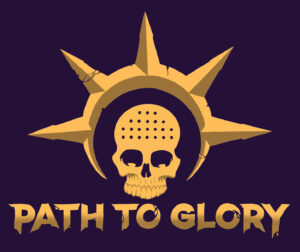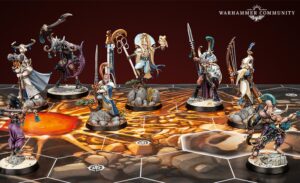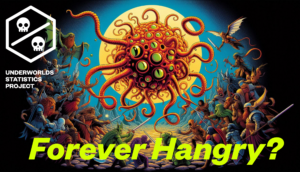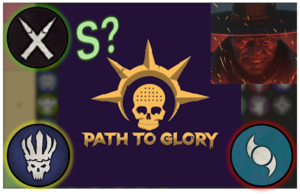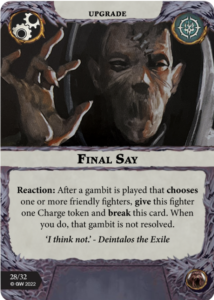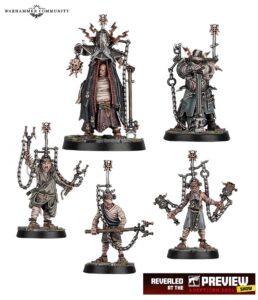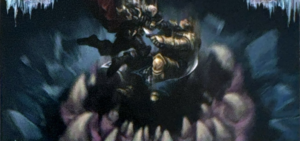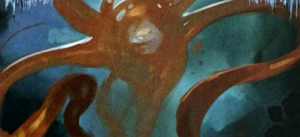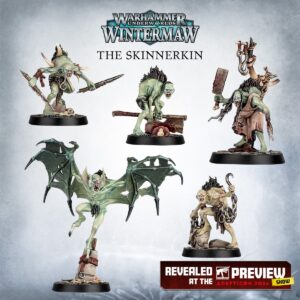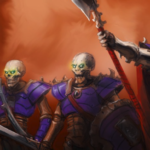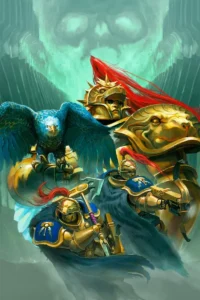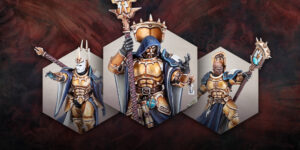Intro
Welcome back for another serving of Bacon’s Bits, the article series where I get to dig into a niche Underworlds topic and weigh in with my opinion. For today’s discussion, I’ll be focusing on Nemesis deckbuilding with the Rimelocked Relics (RR) deck and its comparison to Malevolent Masks (MM). While I will confess to having slightly underrated MM upon its release, my goal with this article will be to “double down” and state that, if you are using MM as your Rivals deck pairing in Nemesis at the moment, I think you ought to be taking a serious look at switching to RR. In particular, I will focus on the use of this deck with warbands which do not have access to fighter resurrection mechanics, as I do think these may be the exception that could afford to stick with MM instead (although you could still make the argument for switching, even with some of those).
The Timeline
While you’re probably quite familiar with these decks if you’ve been tapped into the more recent releases, for the sake of the discussion, I think it is worth getting into the impact on the competitive scene. While some versions of hold objective (HO) gameplay were seen in the Nemesis meta prior to the addition of MM, I think it is fair to say that the popularity of the playstyle has increased since then. While you’d occasionally see something like PoP Stalkers that was more directly in the vein of HO or HO-leaning flex, much of the gameplay seen prior to these releases was fueled by a warband’s Rivals deck, rather than their Nemesis pairing. For example, you probably saw some VC or FF Sepulchral Guard, Dread Pageant, or Sons of Velmorn, but these builds were generally driven less toward HO by their universal pairings and were instead designed behind a concept of supporting the warband’s built-in HO gameplans with additional mobility, push resistance, and general increase in survivability (with a couple universal objective cards for holding mixed in).
Enter MM and suddenly we have a deck besides PoP that is offering appreciable HO support in its objectives, with two surges and two end phases directly asking the player to hold to score them. Furthermore, the end phases actually paid out appreciable glory totals unlike PoP, which struggled to hit a ceiling of even 16 glory and quite often only scored most reliably at something like a 15-glory payout. While some additional synergy in MM mostly is just asking you to have surviving fighters with those upgrades (which is particularly good for resurrection warbands), this carved out a small corner of the meta for dedicated HO synergy, highlighted by the popularization of MM Mournflight as a passive snowball deck that was hard to match, especially for warbands that are uncomfortable playing the beatdown.
Fast-forward one release cycle and a ton of stuff drops essentially all at once. While normally Gravebreakers and RR would have released on their own and gotten a chance to settle in before new content dropped, they were instead paired with the Rivals of the Mirrored City, which suddenly injected all 4 of its redone warbands into varying degrees of meta relevance, giving people a swath of new things to test all at once. This is then compounded by an entire core set release in Wintermaw, introducing two new warbands and two of the most instantly ubiquitous Rivals deck pairings that I think we’ve seen since the official start of the Nemesis format. RR and all its tantalizing flex synergy somewhat immediately falls victim to this deluge of releases and, I think, has been lost in the shuffle a bit, which is why I felt it was worth highlighting today.
Similarities between MM and RR
Objectives
As I hinted at earlier, the most direct impact of MM was the “re-introduction,” so-to-speak, of a gameplan that did not necessarily revolve around running into the middle of the board to score all of your glory. If you had good passive faction surges, you could conceivably throw down mask upgrades with ease and then snowball into the rest of your deck without much interaction. Still, this is not to say the deck was fully functional without interaction, as cards like [![]() Hooded Stranger]
Hooded Stranger]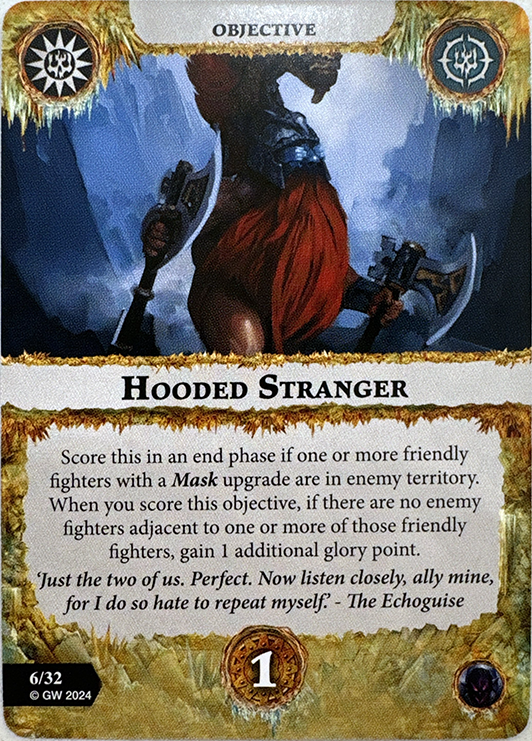 or [
or [![]() Totally Overpowered]
Totally Overpowered]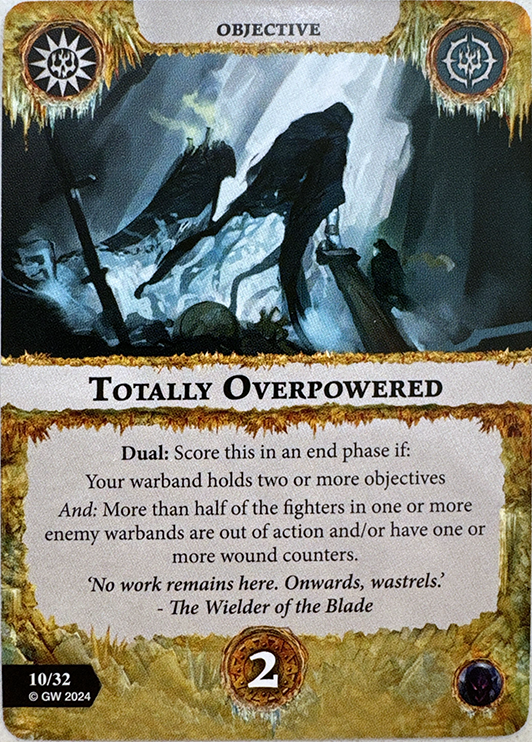 essentially mandated that you offer up at least one of your fighters as a potential mid-board target. While there is a bit more incentive to move forward and pick up kills with RR, the scoring concept is very similar: hold objectives and have particular upgrades while you’re doing it. Yes, there is a bit more incentive to push up the board and make attacks (we’ll get into that in a moment), but this core identity I would say is retained.
essentially mandated that you offer up at least one of your fighters as a potential mid-board target. While there is a bit more incentive to move forward and pick up kills with RR, the scoring concept is very similar: hold objectives and have particular upgrades while you’re doing it. Yes, there is a bit more incentive to push up the board and make attacks (we’ll get into that in a moment), but this core identity I would say is retained.
Gambits
When we look at the power decks, we see some other striking comparisons. The gambits in each are heavily self-contained, with some push/positional tech, additional accuracy, and then a ton of gambits in each that specifically work with the Rivals deck’s schtick or at least only hit their optimal performance in the context of cards present in those Rivals decks (specifically their upgrades).
Upgrades
Speaking of which, the most glaring similarity between these decks is, of course, that they each run on their upgrades. So much of the scoring is baked into the fighters who have the upgrades that you probably are taking a minimum of 4 of them to help your objective deck cycle. Interestingly, I think the upgrades are also where we see some of the most important differences between these two decks, but that will again have to wait just a moment.
Summary
All told, this paints a picture of two decks which will heavily tax your upgrade slots while generally not providing universal gambit effects like you’d more often expect to see. In exchange, you get access to higher throughput HO scoring that does not always care about whether you’re killing lots of your opponent’s fighters, which is an exciting prospect for many warbands that were lacking this exact synergy.
Differences between MM and RR
Objectives
Having gone over the similarities, it’s time to identify what distinguishes these decks from each other, again starting with the objectives. As I hinted at earlier, MM objectives do provide a higher ceiling of non- or minimally-interactive glory. While [![]() Feast of Violence]
Feast of Violence]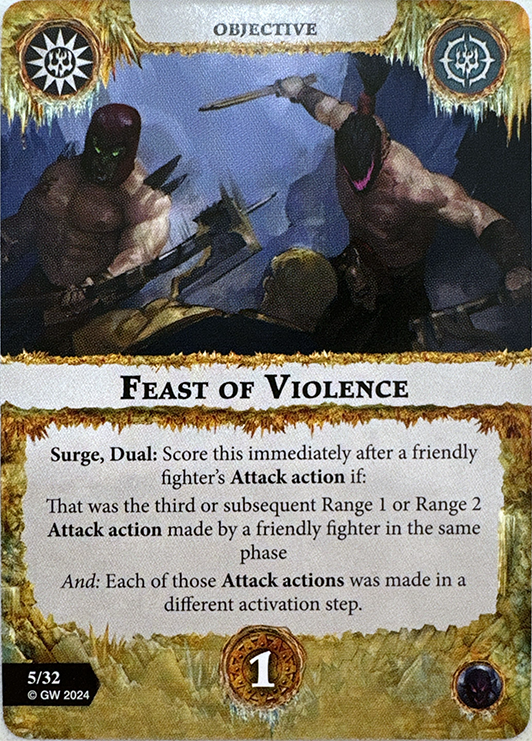 , [
, [![]() Death’s Visage]
Death’s Visage]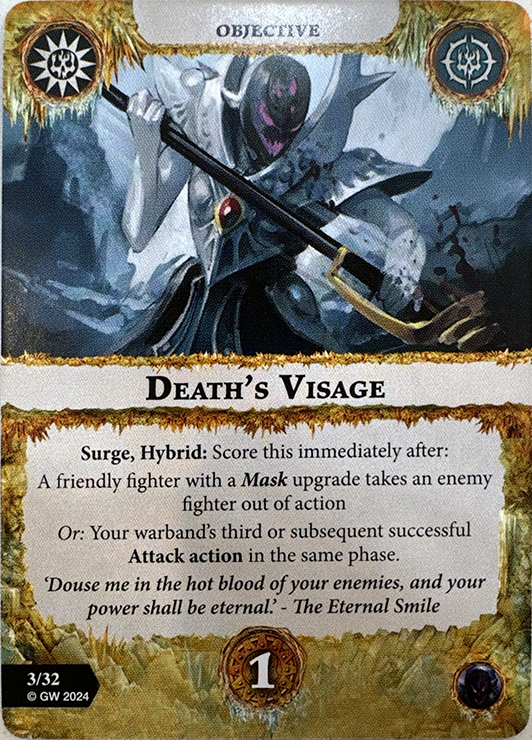 , and [
, and [![]() Slaughter Satisfied]
Slaughter Satisfied]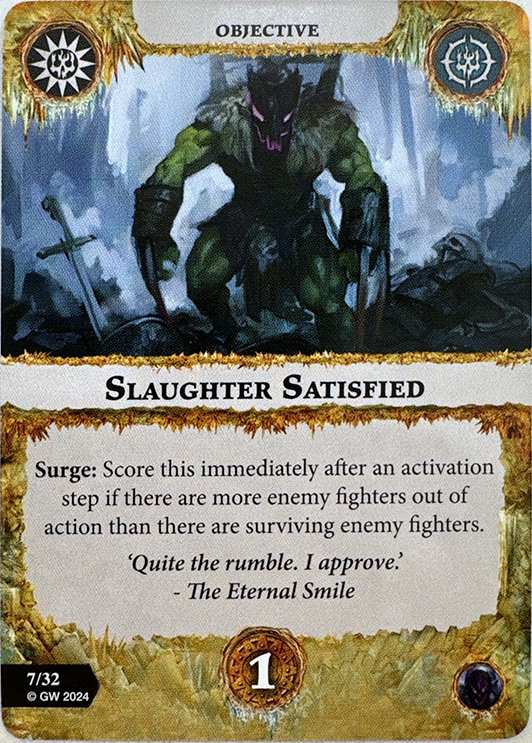 all need heavy interaction, these are often not taken in the most potent MM pairings if the warband has good enough surges at their disposal already. There’s still that bit of push to go forward with [
all need heavy interaction, these are often not taken in the most potent MM pairings if the warband has good enough surges at their disposal already. There’s still that bit of push to go forward with [![]() Hooded Stranger]
Hooded Stranger] , [
, [![]() Solid Spread]
Solid Spread]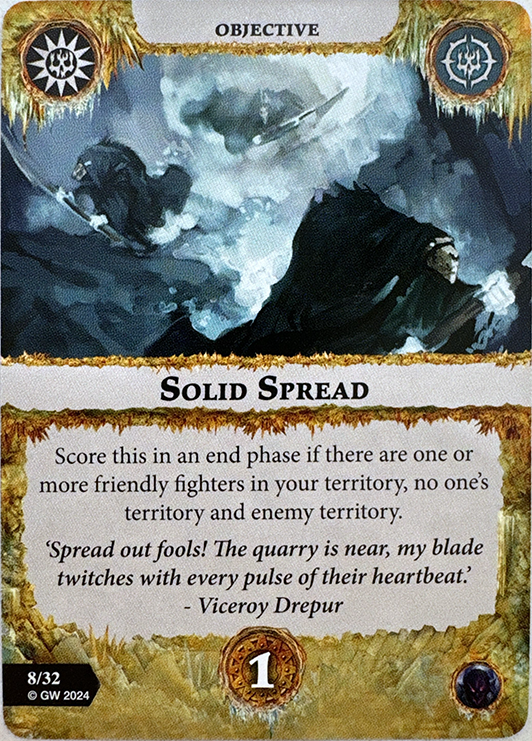 , and [
, and [![]() Totally Overpowered]
Totally Overpowered] (maybe [
(maybe [![]() Completed Pact]
Completed Pact]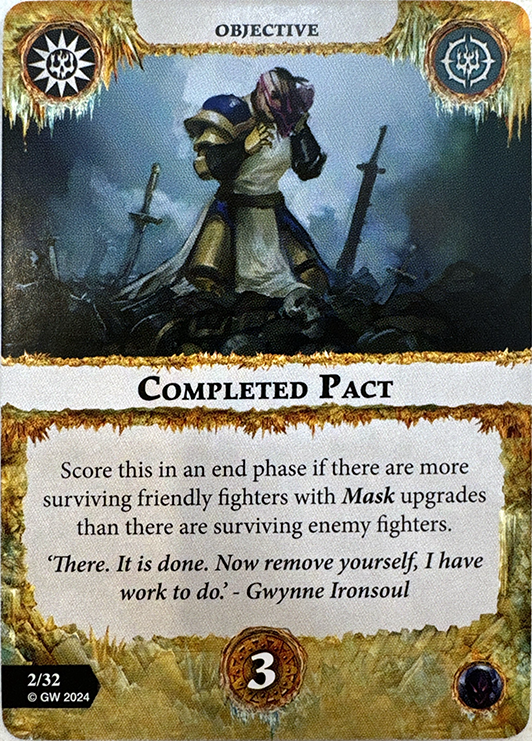 , for certain matchups), but overall, I’d say that’s about as non-interactive as you could hope to play these days, which I think is a good thing for the game as a whole. Meanwhile, RR has a harder flex lean to it. It wants you to hold objectives for even more cards than MM (for example, all 6 surges require you to hold), but it wants you to do so while still engaging in combat. While this might appear at first to be a big win in favor of MM, many warbands have faction cards/mechanics which incentivize and actually thrive off this exact playstyle anyway, even those which are currently (to various extents) using the MM pairing such as Sepulchral Guard, Mournflight, and Sons of Velmorn. It’s worth noting that these are also reliant on some degree of interaction for inspiring their fighters anyway. While the potential for more passivity is prevalent in the MM pairing, it also means that it packs less scoring to account for the interactivity of the current meta as compared to RR, which I think will even out in the long run.
, for certain matchups), but overall, I’d say that’s about as non-interactive as you could hope to play these days, which I think is a good thing for the game as a whole. Meanwhile, RR has a harder flex lean to it. It wants you to hold objectives for even more cards than MM (for example, all 6 surges require you to hold), but it wants you to do so while still engaging in combat. While this might appear at first to be a big win in favor of MM, many warbands have faction cards/mechanics which incentivize and actually thrive off this exact playstyle anyway, even those which are currently (to various extents) using the MM pairing such as Sepulchral Guard, Mournflight, and Sons of Velmorn. It’s worth noting that these are also reliant on some degree of interaction for inspiring their fighters anyway. While the potential for more passivity is prevalent in the MM pairing, it also means that it packs less scoring to account for the interactivity of the current meta as compared to RR, which I think will even out in the long run.
Gambits
As discussed in the earlier section, I think the gambits largely have a lot of overlap between these two decks. You’ve got a lot of stuff that interacts with cards in the Rivals decks but quickly loses universal appeal in a Nemesis or Championship pairing. However, one notable and important distinction is in the pushes. It might not sound like much, but just going from 1 push card to 2 can be a huge deal (specifically in Nemesis), even with how restrictive the play conditions might be. Furthermore, I’ll take [![]() Cool Heads]
Cool Heads] over [
over [![]() Possessive Crouch]
Possessive Crouch]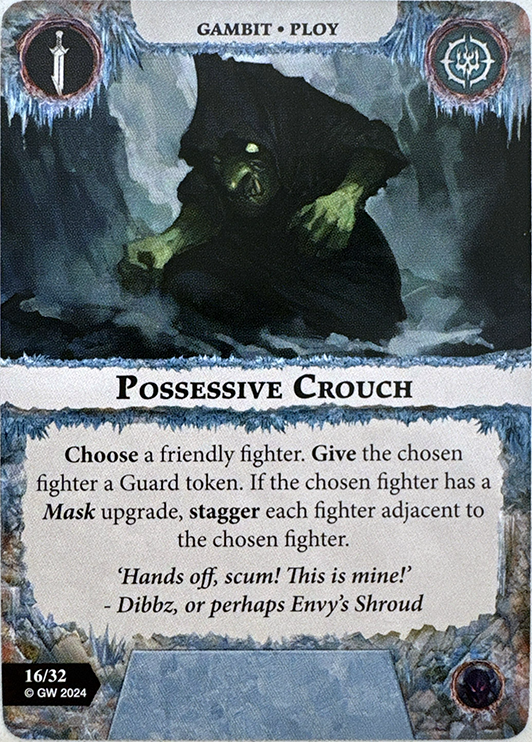 on most builds as my gambit to “secure” my positional scoring (whether via surge or end phase). Given the release of Hungering Parasite, I would, however, be remiss to not point out that [
on most builds as my gambit to “secure” my positional scoring (whether via surge or end phase). Given the release of Hungering Parasite, I would, however, be remiss to not point out that [![]() Revealed Aspect]
Revealed Aspect]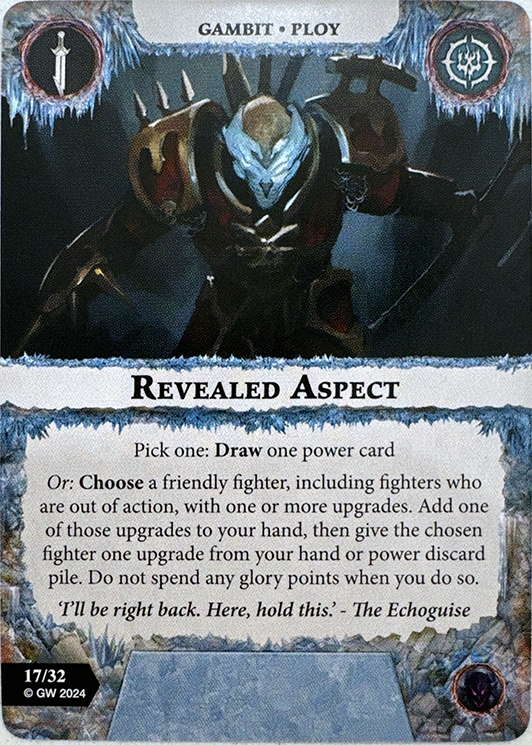 is one of the best ways to counter the Bane of Heroes in the game. While I do think a lot of the RR gambits could very well be left on the cutting room floor, and that may be some motivation towards MM, I find that many of these warbands have more than enough solid in-faction gambits to compensate these days and just take the peak value gambits, which I think makes this closer to a wash or a slight edge to RR.
is one of the best ways to counter the Bane of Heroes in the game. While I do think a lot of the RR gambits could very well be left on the cutting room floor, and that may be some motivation towards MM, I find that many of these warbands have more than enough solid in-faction gambits to compensate these days and just take the peak value gambits, which I think makes this closer to a wash or a slight edge to RR.
Upgrades
Lastly, and most importantly, we talked earlier about needing to pay the “upgrade tax” to access the scoring in each of these decks. I would argue that, barring some insane faction Rivals deck synergy, to make either deck work, at least 4 of your upgrades should be mask/rimelock upgrades, with my personal preference being 5. This is a pretty significant tax on your deck build that, while it homogenizes your scoring, warrants further investigation when you consider that there are plenty of strategies, such as aggro, where upgrades not only provide direct scoring synergy but also provide generally useful effects such as accuracy and damage. If we’re going to be paying this tax, it would be nice to get something out of it. This is where I think the disparity between the two decks becomes most apparent. Most of the mask upgrades are useful only in very specific scenarios if you have an activation to burn, and/or one of the free mask action gambits in your hand. You also can’t stack multiple of them onto the same fighter, meaning you may reach decision points in the game where you must cannibalize your own upgrade in order to access a more relevant effect. Not only does RR circumvent this competitive usage, but the average power level of the rimelocked upgrades is miles beyond that of the masks. Yes, you need to wait for them to thaw and that can be very unfortunate when you need them ASAP, but there is tech available in the deck to support faster unlocks. I would argue the waiting is a far less significant downside than only being able to use one at a time on a given fighter, especially when factoring in the efficacy of the upgrades themselves. Additionally, the masks (barring limited gambit support) will require spending activations to actually have their effects come online anyway. Furthermore, in my opinion, the downside for rimelock is not a hard cap on the power ceiling (as is the case with masks), it is a learning curve. Yes, the curve will be steeper with RR as you have to learn when is best to play the upgrades, how opponents tend to respond when you play them face down, etc. Ultimately, with enough reps, I think you can “solve” that. You can learn whether you want particular upgrades to thaw after your activation or after your opponent’s. You can leverage the hidden information to your advantage via mind games of what upgrade that could be or you could bait your opponent into an unsafe charge just to deny use of particular upgrades. Even if you somehow disagree that the rimelocked upgrades have better effects than the mask upgrades, the more “universal” upgrades in RR are also superior to those in MM. [![]() Rimewyrm Skin Boots]
Rimewyrm Skin Boots] and [
and [![]() The Snowblind Cloak]
The Snowblind Cloak] , I would argue, are generally better upgrades than any non-mask upgrade in MM (and even most, if not all, of the masks themselves), with [
, I would argue, are generally better upgrades than any non-mask upgrade in MM (and even most, if not all, of the masks themselves), with [![]() Chillblain Armour]
Chillblain Armour] also factoring in for warbands in this conversation that don’t naturally get 2 Defence dice. While it was close or maybe even on the objectives and gambits (depending on your warband choice), it’s absolutely no contest for me on the upgrades and RR has the clear edge.
also factoring in for warbands in this conversation that don’t naturally get 2 Defence dice. While it was close or maybe even on the objectives and gambits (depending on your warband choice), it’s absolutely no contest for me on the upgrades and RR has the clear edge.
Example Case (MM vs. RR Mournflight)
The Decks
For fun, I have taken an example case of the “poster child” of non-resurrection MM builds with Lady Harrow’s Mournflight and built what I think are at least close to the optimal Nemesis decks for MM and RR. You could go back and forth about a few card choices, but I would be surprised to see more than a few cards difference between these and their “solved” decks. My goal is to show that the RR build doesn’t really “lack” anything that MM was trying to do, it just further augments it.
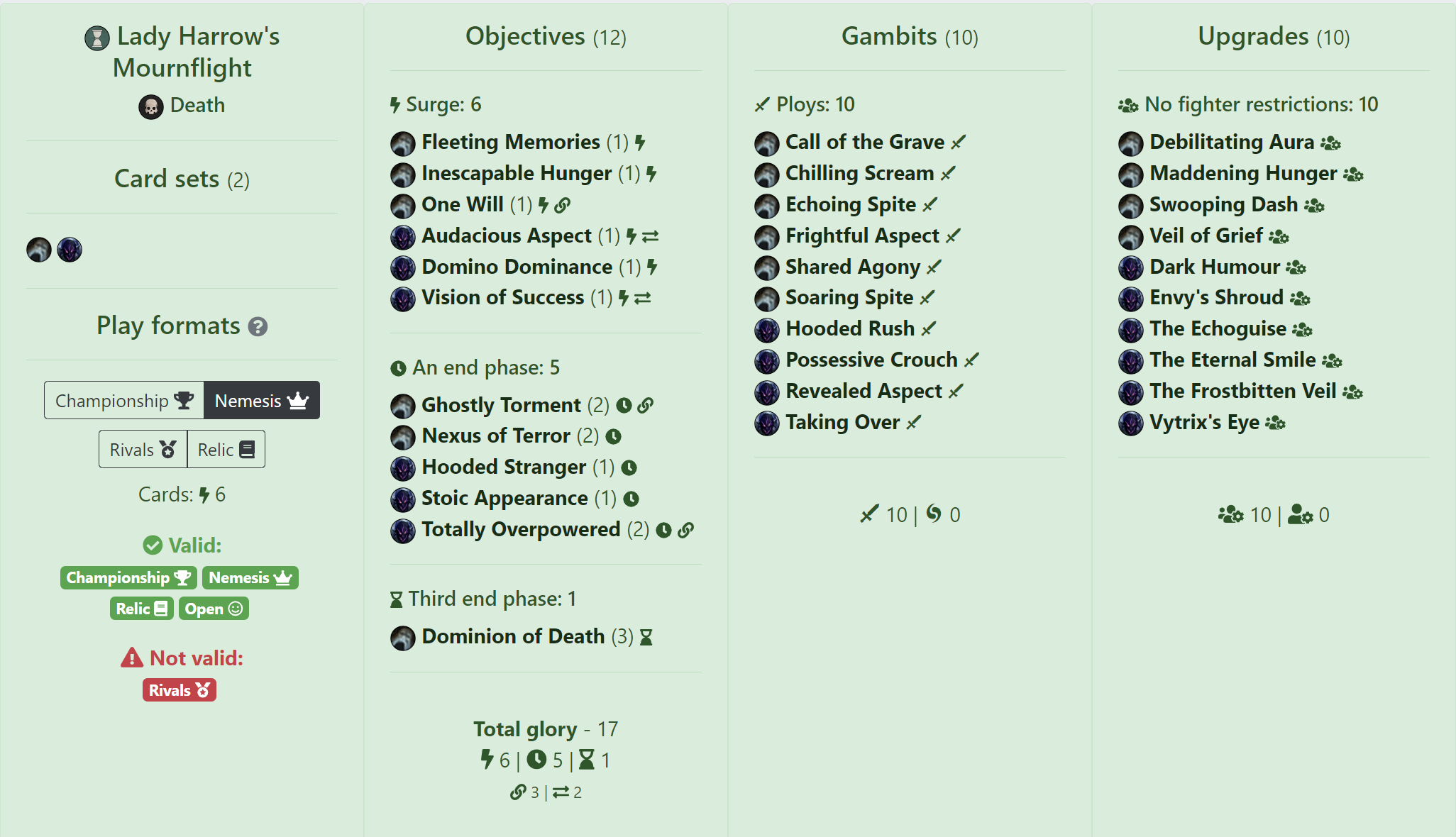
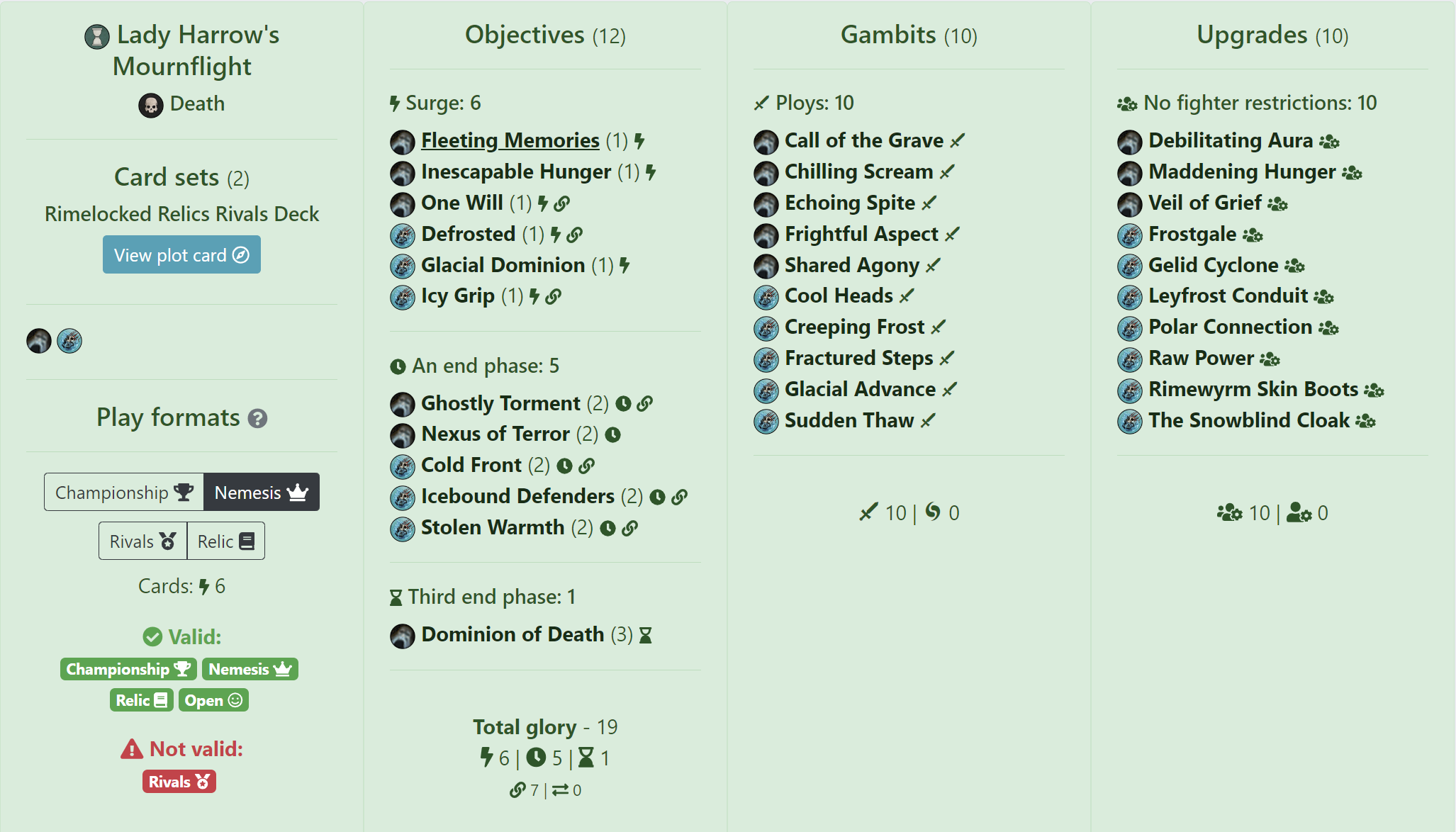
Objective Comparison
Pairing them side-by-side, you can see some of the similarities we discussed. While I’ve subbed in [![]() Defrosted]
Defrosted] and [
and [![]() Glacial Dominion]
Glacial Dominion] for [
for [![]() Audacious Aspect]
Audacious Aspect]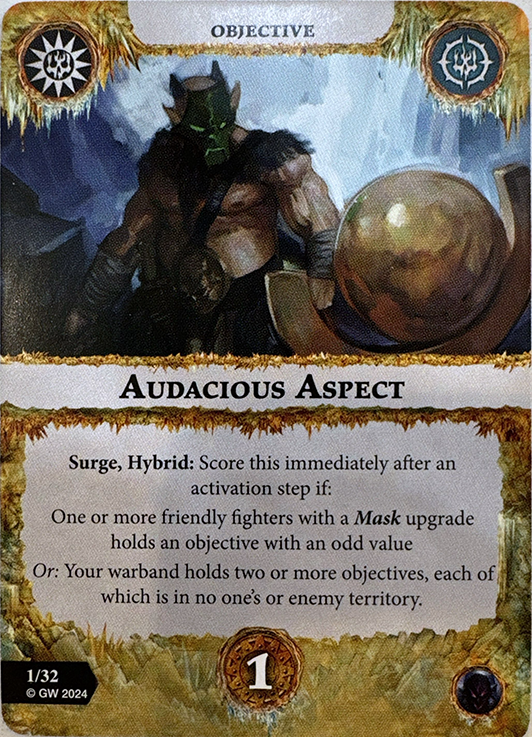 and [
and [![]() Vision of Success]
Vision of Success]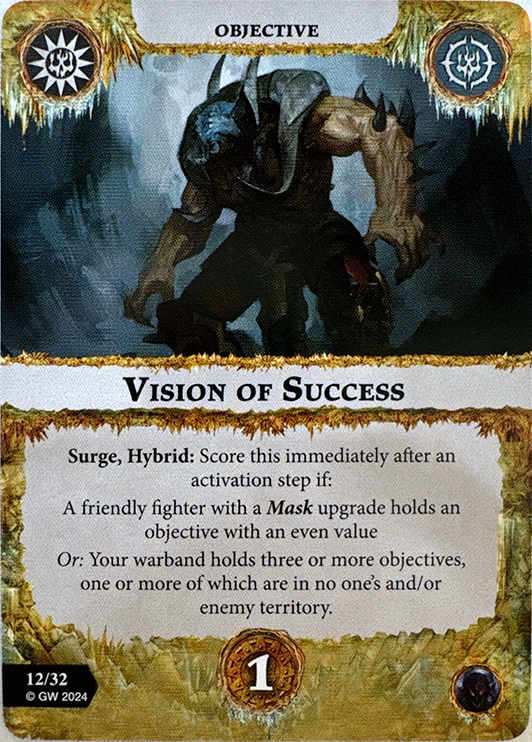 , to show the parallel play pattern offered by the RR surges, I do think I’d generally prefer [
, to show the parallel play pattern offered by the RR surges, I do think I’d generally prefer [![]() Frostbitten Strike]
Frostbitten Strike] over [
over [![]() Defrosted]
Defrosted] . In either case, both surge packages offer, in my opinion, just about the same level of un‑interactive scoring. The forward placement of a fighter to score [
. In either case, both surge packages offer, in my opinion, just about the same level of un‑interactive scoring. The forward placement of a fighter to score [![]() Domino Dominance]
Domino Dominance]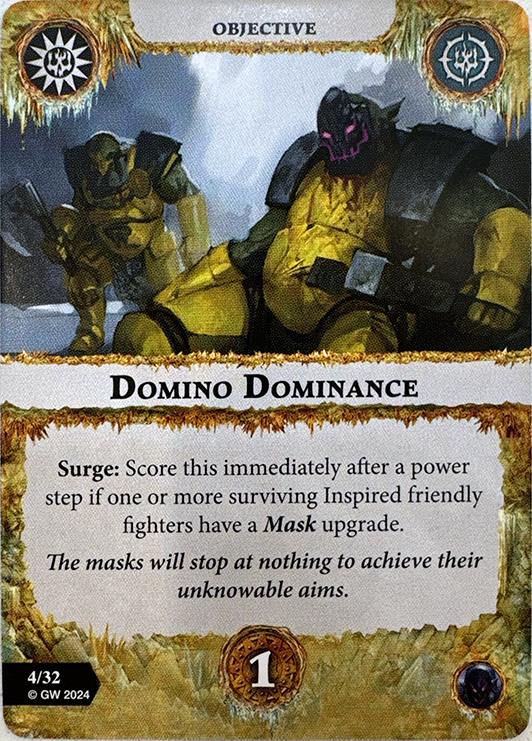 and [
and [![]() Hooded Stranger]
Hooded Stranger] is mirrored by the need to do so for [
is mirrored by the need to do so for [![]() Icy Grip]
Icy Grip] and [
and [![]() Icebound Defenders]
Icebound Defenders] , while [
, while [![]() Cold Front]
Cold Front] and [
and [![]() Totally Overpowered]
Totally Overpowered] are nice analogs for each other in terms of flex-hold gameplan. The biggest difference is between [
are nice analogs for each other in terms of flex-hold gameplan. The biggest difference is between [![]() Stolen Warmth]
Stolen Warmth] and [
and [![]() Stoic Appearance]
Stoic Appearance]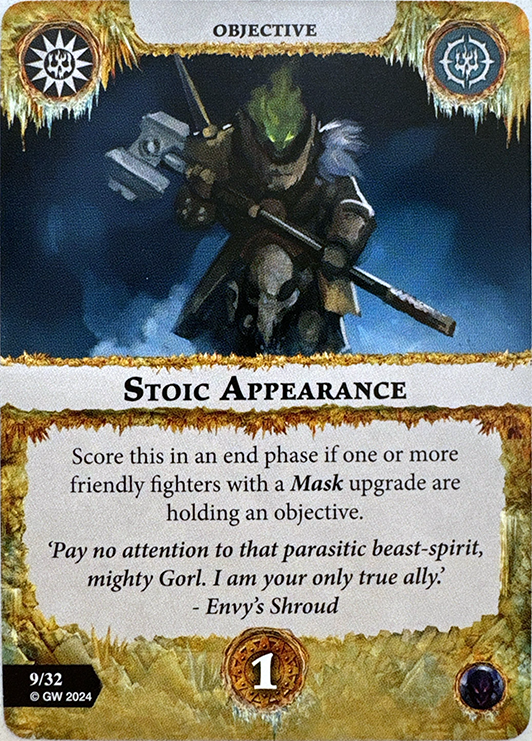 . You could maybe sub in [
. You could maybe sub in [![]() A Line in the Snow]
A Line in the Snow] or [
or [![]() Creeping Dread]
Creeping Dread]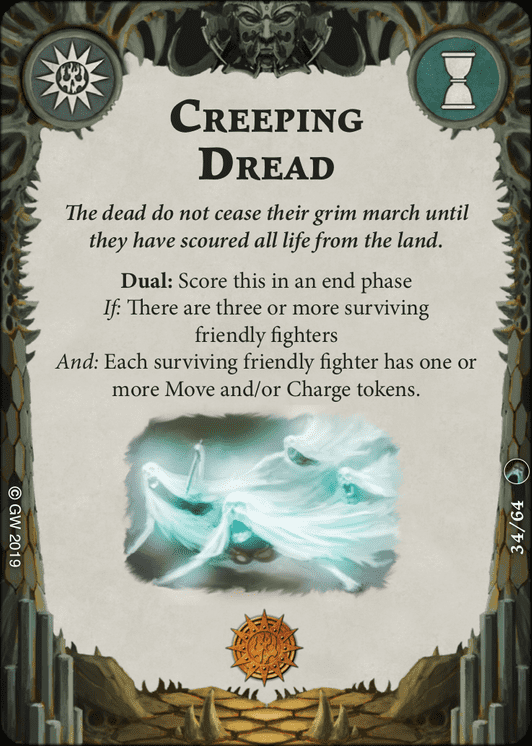 or something, but I do think RR lacks an obvious “6th end phase card.” Still, [
or something, but I do think RR lacks an obvious “6th end phase card.” Still, [![]() Stolen Warmth]
Stolen Warmth] offers a nice analog to what used to be [
offers a nice analog to what used to be [![]() Chill of the Grave]
Chill of the Grave]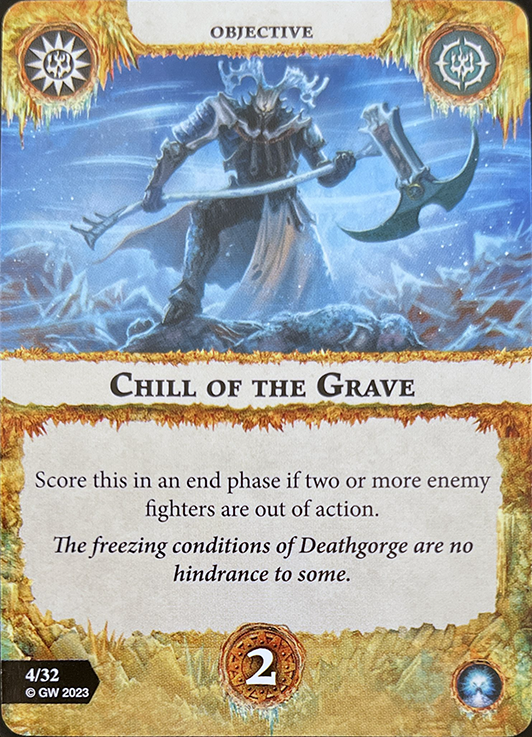 in the FoF pairing (prior to the nerf), with the obvious caveat that you need two rimelock-equipped friendly fighters to be surviving to score it. For this pairing, you might give a very slight edge to MM on the objectives, but 11 of the 12 are essentially mirrored between the two builds. The gameplan is effectively the same.
in the FoF pairing (prior to the nerf), with the obvious caveat that you need two rimelock-equipped friendly fighters to be surviving to score it. For this pairing, you might give a very slight edge to MM on the objectives, but 11 of the 12 are essentially mirrored between the two builds. The gameplan is effectively the same.
Gambits
The gambits, again, feel quite similar. RR offers an additional push card, but a good one, in [![]() Glacial Advance]
Glacial Advance] , in exchange for [
, in exchange for [![]() Fractured Steps]
Fractured Steps] being less consistent than [
being less consistent than [![]() Hooded Rush]
Hooded Rush]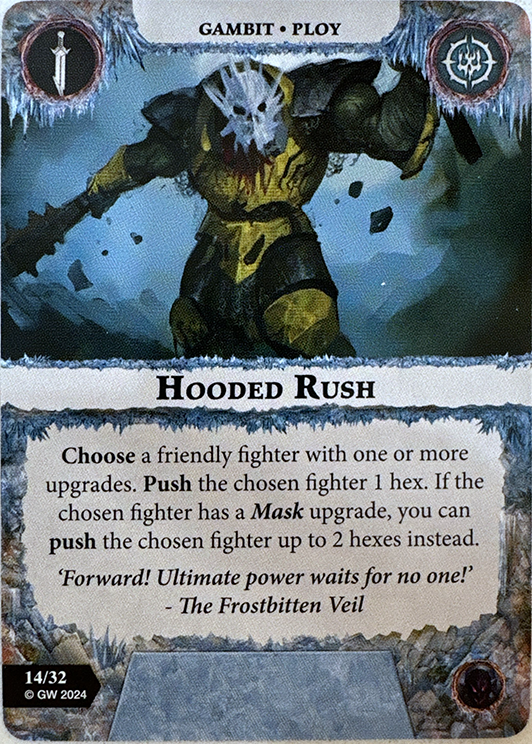 . [
. [![]() Cool Heads]
Cool Heads] and [
and [![]() Possessive Crouch]
Possessive Crouch] are somewhat related, but serve slightly different purposes, with an edge for me on the former due to the board-wide effect. Meanwhile, you’ll notice that I’ve pulled [
are somewhat related, but serve slightly different purposes, with an edge for me on the former due to the board-wide effect. Meanwhile, you’ll notice that I’ve pulled [![]() Soaring Spite]
Soaring Spite]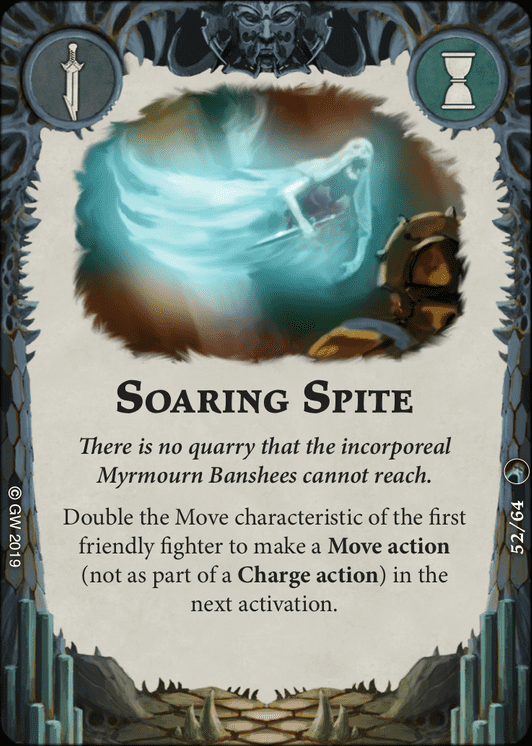 out due to RR’s need to make a few more attack actions, allowing me to sub in [
out due to RR’s need to make a few more attack actions, allowing me to sub in [![]() Creeping Frost]
Creeping Frost] (which could just as easily be [
(which could just as easily be [![]() Spectral Charge]
Spectral Charge]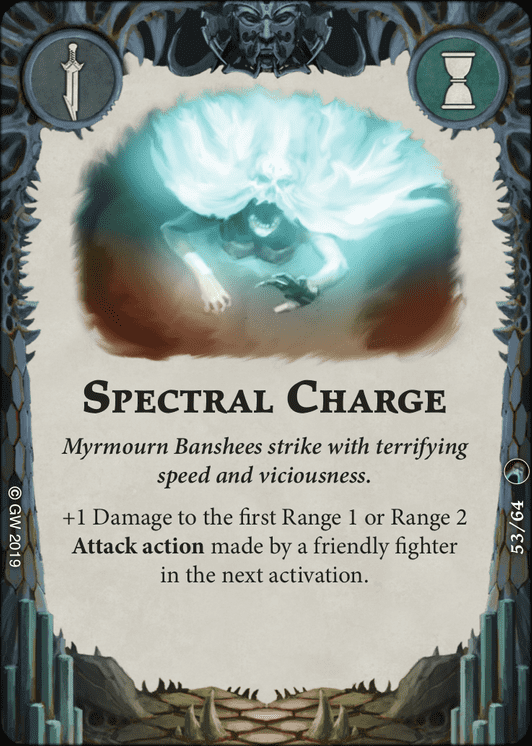 , if you prefer) instead for some increased damage output. [
, if you prefer) instead for some increased damage output. [![]() Taking Over]
Taking Over]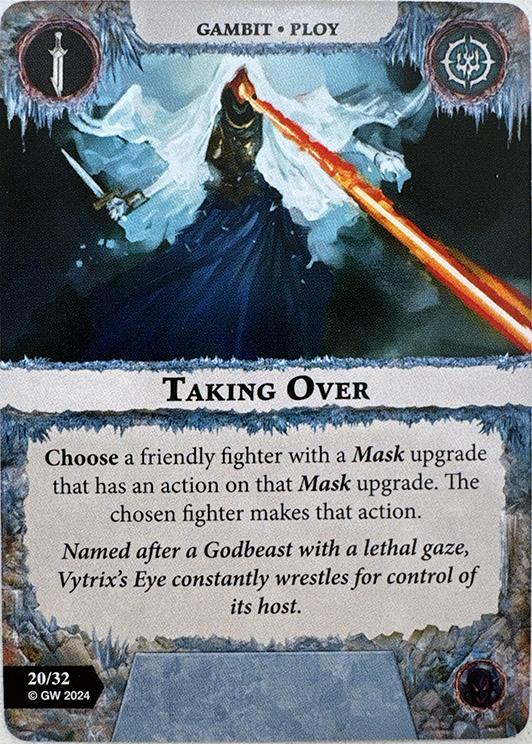 , while a pretty solid effect, is essentially a power card tax of MM to save you an activation, whereas [
, while a pretty solid effect, is essentially a power card tax of MM to save you an activation, whereas [![]() Sudden Thaw]
Sudden Thaw] not only saves you turns of waiting for your upgrades to flip, but also offers a critical domain keyword that can help to counteract scary things being done in Rimewyrm’s Bite (although it can, of course, be countered itself). Like we discussed earlier, the gambits, like the objectives, ring pretty similar in terms of their usefulness, but here I think [
not only saves you turns of waiting for your upgrades to flip, but also offers a critical domain keyword that can help to counteract scary things being done in Rimewyrm’s Bite (although it can, of course, be countered itself). Like we discussed earlier, the gambits, like the objectives, ring pretty similar in terms of their usefulness, but here I think [![]() Glacial Advance]
Glacial Advance] and [
and [![]() Cool Heads]
Cool Heads] are enough to make me slightly prefer RR.
are enough to make me slightly prefer RR.
Upgrades
Again, as we discussed earlier, the upgrades are where I think RR really outshines MM. In particular, [![]() Gelid Cyclone]
Gelid Cyclone] is just incredible given that positioning onto tokens and making a charge with these Range 1 ladies can often be difficult. The one-time teleport is obviously the most significant form of this repositioning (you can pop right up on that odd or even token, as needed), but even just the post-activation push is absolute cash money for a warband that lacks an in-faction [
is just incredible given that positioning onto tokens and making a charge with these Range 1 ladies can often be difficult. The one-time teleport is obviously the most significant form of this repositioning (you can pop right up on that odd or even token, as needed), but even just the post-activation push is absolute cash money for a warband that lacks an in-faction [![]() Sidestep]
Sidestep]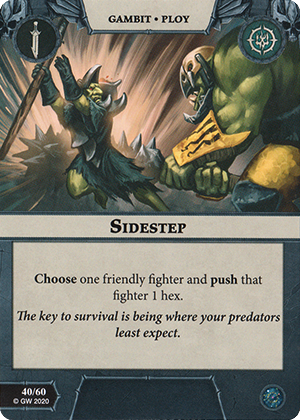 (barring your inspired leader’s reaction). Additionally, [
(barring your inspired leader’s reaction). Additionally, [![]() Leyfrost Conduit]
Leyfrost Conduit] not only acts as an accuracy upgrade (both for the user and for your other fighters, but also a board-wide defensive support to stack with your 2-Dodge. Meanwhile, [
not only acts as an accuracy upgrade (both for the user and for your other fighters, but also a board-wide defensive support to stack with your 2-Dodge. Meanwhile, [![]() Frostgale]
Frostgale] is an improvement on [
is an improvement on [![]() Vytrix’s Eye]
Vytrix’s Eye]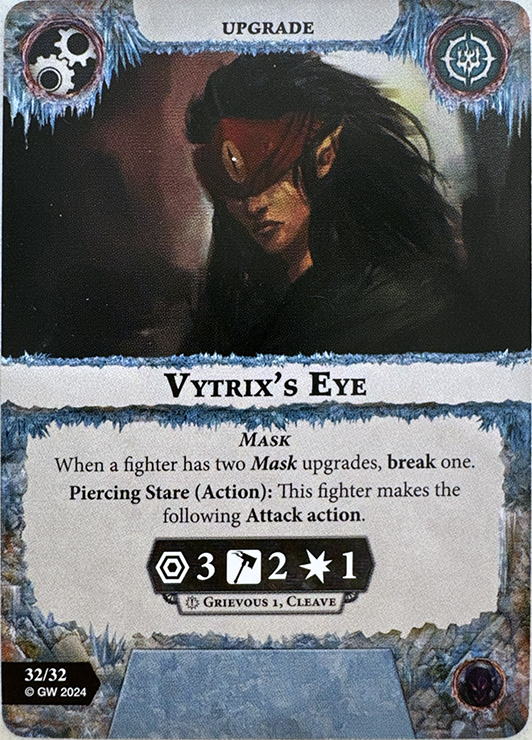 (extra range and better accuracy, in addition to being able to use it during a charge, edges out 2-Dice grievous potential), [
(extra range and better accuracy, in addition to being able to use it during a charge, edges out 2-Dice grievous potential), [![]() Polar Connection]
Polar Connection] , while not quite as directly powerful of an effect as [
, while not quite as directly powerful of an effect as [![]() The Frostbitten Veil]
The Frostbitten Veil]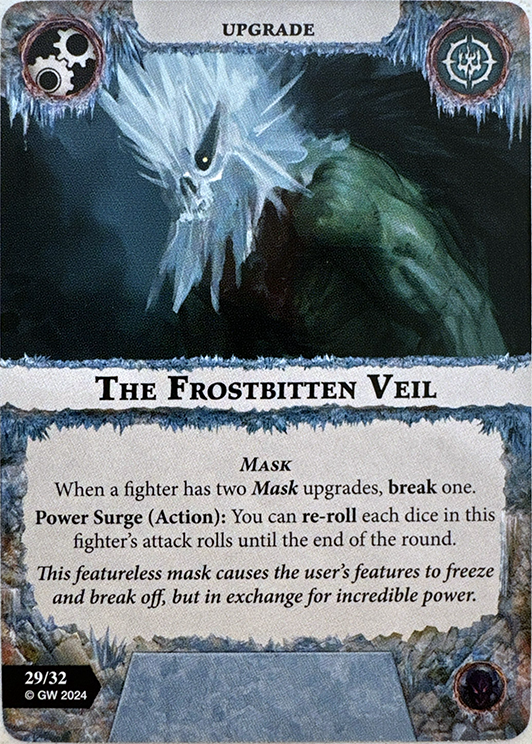 , does not have the tax of spending an activation to unlock the effect and the synergy with [
, does not have the tax of spending an activation to unlock the effect and the synergy with [![]() Leyfrost Conduit]
Leyfrost Conduit] (which you’d presumably put onto a different fighter) can be incredible. [
(which you’d presumably put onto a different fighter) can be incredible. [![]() Raw Power]
Raw Power] is your less consistent replacement for [
is your less consistent replacement for [![]() The Eternal Smile]
The Eternal Smile]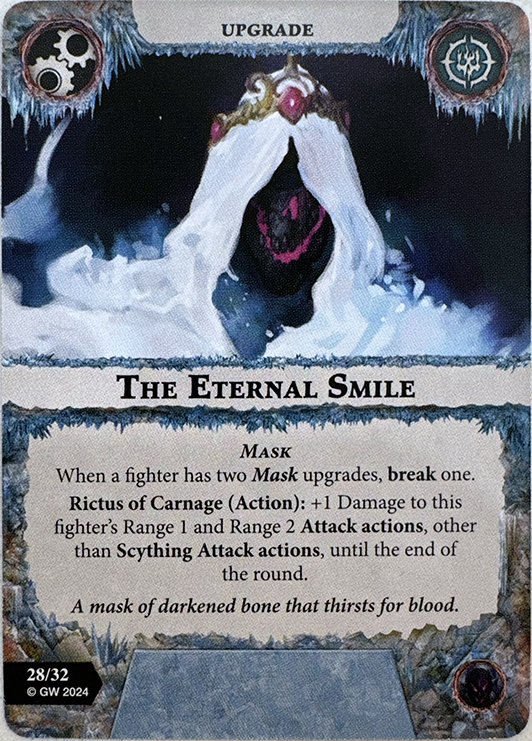 (but notably, again, does not cost an activation). [
(but notably, again, does not cost an activation). [![]() The Snowblind Cloak]
The Snowblind Cloak] somewhat provides the [
somewhat provides the [![]() Envy’s Shroud]
Envy’s Shroud]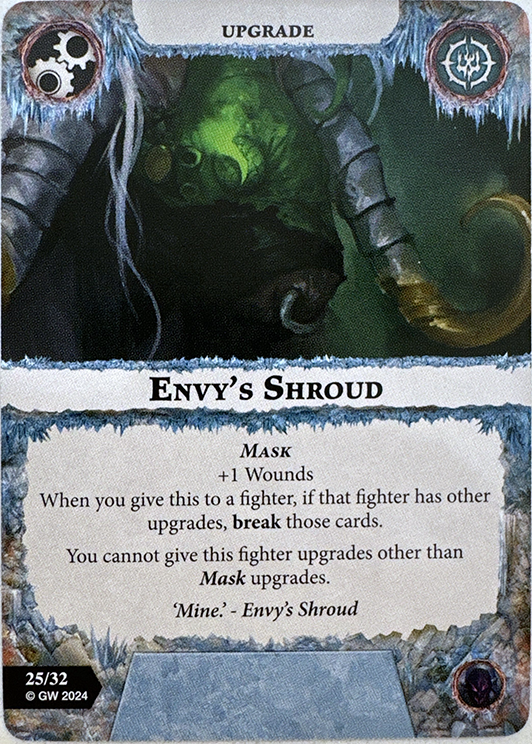 effect since it can improve the survivability of your fighters without making them Large (at the cost of a positional component). The cherry on top is the [
effect since it can improve the survivability of your fighters without making them Large (at the cost of a positional component). The cherry on top is the [![]() Rimewyrm Skin Boots]
Rimewyrm Skin Boots] , as your opponent being unable to push one of your fighters (especially if they are holding a critical token) is a consistently underrated effect, even more so considering some of the Rimewyrm’s Bite cards that it can prevent from working on the equipped fighter. And, of course, we can’t forget that the beauty of these compared to masks is that you can actually have more than one on a fighter at any given time. Sure, you have to wait 3 activations to access the effects, but you’re waiting that long to access the strongest two effects from masks anyway (again, assuming you have to spend an activation performing the action). The upgrades are just such a massive improvement, it’s no contest for me that RR wins here.
, as your opponent being unable to push one of your fighters (especially if they are holding a critical token) is a consistently underrated effect, even more so considering some of the Rimewyrm’s Bite cards that it can prevent from working on the equipped fighter. And, of course, we can’t forget that the beauty of these compared to masks is that you can actually have more than one on a fighter at any given time. Sure, you have to wait 3 activations to access the effects, but you’re waiting that long to access the strongest two effects from masks anyway (again, assuming you have to spend an activation performing the action). The upgrades are just such a massive improvement, it’s no contest for me that RR wins here.
The Winner…?
While I understand it may not be the case for everyone, looking at these decks side-by-side has only further convinced me of my position. I think, with a swap from MM to RR, you are essentially paying the cost of having a less consistent 6th end phase objective for a slightly higher scoring ceiling and a massive bump in upgrade utility/accessibility in this pairing. For other warbands, like Sons of Velmorn, I believe that contrast to be even more stark, but I felt Mournflight was ultimately the best example of something that was already succeeding with MM that could be almost strictly improved by making the swap to RR. If that’s the case for them despite not even being the warband that best synergizes with the deck, what else are you missing out on if you haven’t tried it out RR yet?
Conclusion
If you’re not convinced by the end of this article, that’s honestly totally fair. There are plenty of applications that I wasn’t able to get into, like how [![]() Revealed Aspect]
Revealed Aspect] can pick up the Bane of Heroes or a false gift upgrade from one of your fighters, or how [
can pick up the Bane of Heroes or a false gift upgrade from one of your fighters, or how [![]() The Echoguise]
The Echoguise]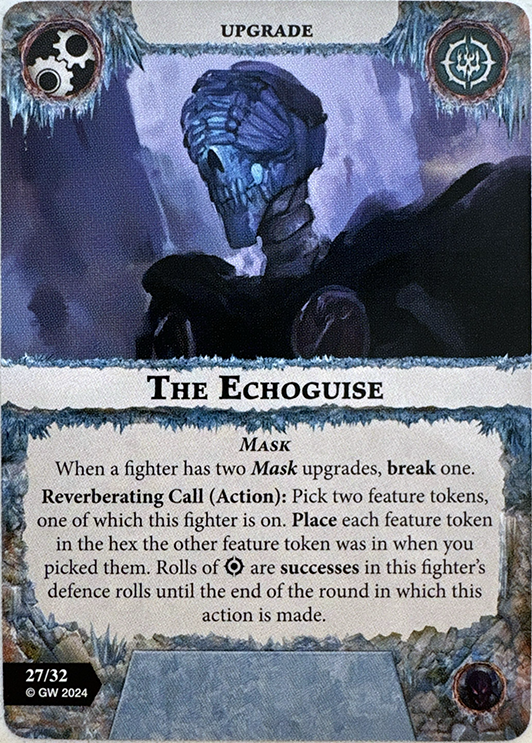 can give you objective number manipulation (which, to be fair, is not very important in RR builds) for tiebreakers and scoring. Additionally, I didn’t talk much about [
can give you objective number manipulation (which, to be fair, is not very important in RR builds) for tiebreakers and scoring. Additionally, I didn’t talk much about [![]() Victorious Veils]
Victorious Veils]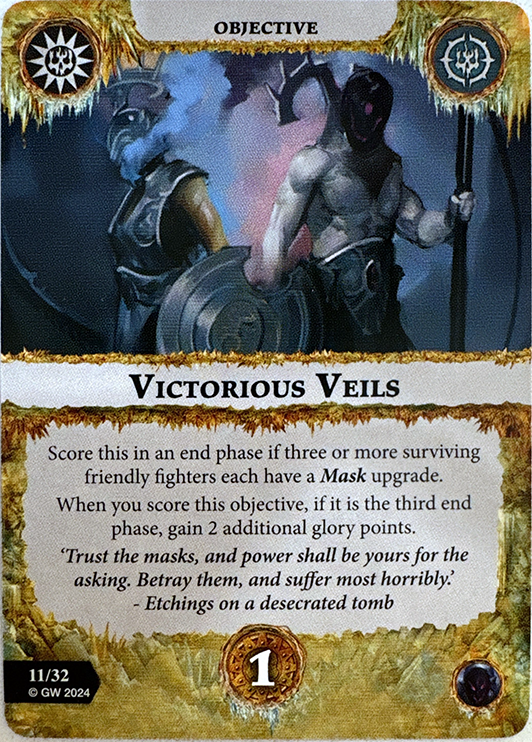 and [
and [![]() Completed Pact]
Completed Pact] (although I did constrain most of my commentary to focus on non-resurrection warbands), which are a big edge that MM can offer resurrection play. All that aside, I do think my thesis generally stands up to the added scrutiny. While RR may not be the most glamorous option of the new releases, I strongly feel that it is not being played enough right now and deserves some more attention outside of just us sad few still trying to make Sons of Velmorn work. The payout won’t be as instant as something like Hungering Parasite or Rimewyrm’s Bite (both of which need some balance adjustments, in my opinion), but I think that once you get past the initial learning curve, there is a lot to be gained by playing this deck. What do you guys think? Are you enjoying RR so far or are you an MM ride-or-die? Feel free to comment on how far off-base (or not off-base, as the case may be) you think I am.
(although I did constrain most of my commentary to focus on non-resurrection warbands), which are a big edge that MM can offer resurrection play. All that aside, I do think my thesis generally stands up to the added scrutiny. While RR may not be the most glamorous option of the new releases, I strongly feel that it is not being played enough right now and deserves some more attention outside of just us sad few still trying to make Sons of Velmorn work. The payout won’t be as instant as something like Hungering Parasite or Rimewyrm’s Bite (both of which need some balance adjustments, in my opinion), but I think that once you get past the initial learning curve, there is a lot to be gained by playing this deck. What do you guys think? Are you enjoying RR so far or are you an MM ride-or-die? Feel free to comment on how far off-base (or not off-base, as the case may be) you think I am.
I hope you guys are liking the article series, and please, if you think you’ve got a good idea, I’m always open to suggestions for new topics to explore or ways to improve the format. Once again, I’d like to thank you all for reading and wish you the best of luck on YOUR Path to Glory! Stay frosty!
